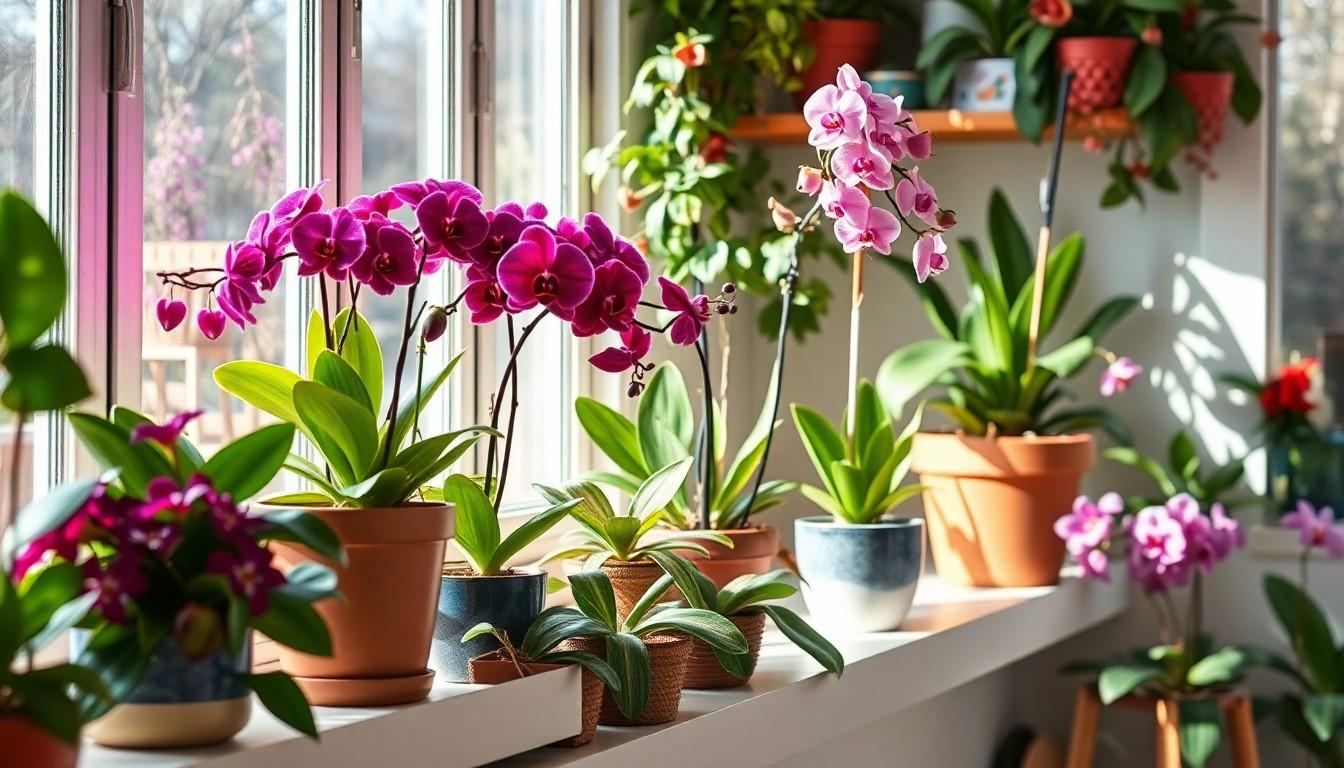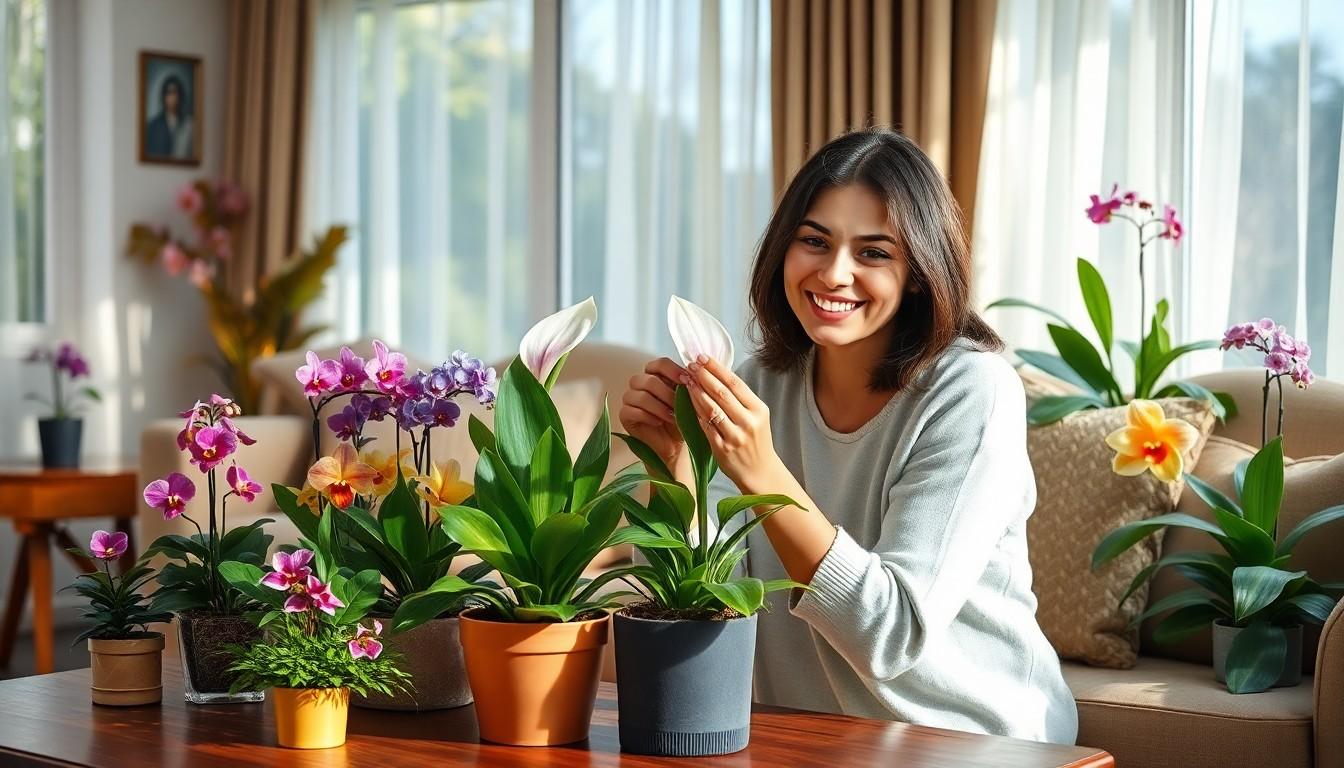Indoor blooming plants can transform any space from drab to fab faster than you can say “green thumb.” Imagine walking into a room where vibrant colors and delightful fragrances greet you, instantly lifting your spirits. These botanical beauties not only brighten your day but also purify the air, making them the ultimate multitaskers in the plant world.
Whether you’re a seasoned plant parent or just starting your indoor jungle, there’s a blooming companion out there for everyone. From the charming African violet to the show-stopping hibiscus, these plants bring life to your home and a touch of nature’s artistry. So why settle for boring decor when you can invite a little floral flair into your life? Get ready to embrace the joy of indoor gardening and watch as your space blossoms into a sanctuary of color and cheer.
Overview of Indoor Blooming Plants
Indoor blooming plants enhance living spaces by offering vibrant colors and delightful fragrances. These plants create a welcoming atmosphere and provide aesthetic appeal in homes and offices. Popular options include African violets, which produce stunning purple flowers, and hibiscus, known for its large, tropical blooms.
Another noteworthy choice is peace lilies. They showcase elegant white flowers and thrive in low light, making them suitable for various interior environments. Orchids also deserve mention for their exotic appearance and extended blooming period. Maintaining these plants typically requires simple care routines.
Watering practices influence blooming duration. Most indoor flowering plants prefer consistent moisture, though overwatering can lead to root rot. Fertilization is equally crucial, especially during the growing season, to support healthy growth and vibrant blooms.
Light requirements vary. Some plants thrive in indirect sunlight, while others necessitate brighter conditions for optimal flowering. Positioning plants correctly enhances their growth potential while preventing leggy appearance.
Pest management should not be overlooked. Common pests like aphids and spider mites might attack blooming plants, yet regular inspection and appropriate treatments can mitigate damage. With the right care, indoor blooming plants transform spaces into lush, fragrant retreats. Their ability to purify air complements aesthetic qualities, enriching indoor environments.
Benefits of Indoor Blooming Plants

Indoor blooming plants provide numerous advantages, enhancing both living spaces and well-being. These plants contribute to the atmosphere by bringing a vibrant touch to any room.
Enhancing Aesthetics
Aesthetics significantly improve with indoor blooming plants. Colors add warmth and charm, transforming simple decor into inviting spaces. Various species, like African violets and orchids, offer diverse hues and shapes, catering to individual preferences. Blooming plants serve as focal points in rooms, drawing attention and admiration. Additionally, their varying heights create visual interest, making each plant a unique addition. Placing these plants on windowsills or shelves further elevates their presence, enriching the overall decor.
Improving Air Quality
Air quality benefits notably from indoor blooming plants. Many species act as natural air purifiers, absorbing toxins and releasing oxygen. For example, peace lilies and spider plants effectively filter harmful pollutants like formaldehyde and benzene. Health improvements occur as cleaner air enhances respiratory function and boosts mood. Certain plants even contribute to humidity levels, alleviating dryness and discomfort. Incorporating these plants into indoor spaces results in fresher air, promoting an overall healthier living environment.
Popular Types of Indoor Blooming Plants
Indoor blooming plants offer a variety of options that enhance any decor while purifying the air. Exploring popular types helps homeowners choose the right plants for their spaces.
African Violets
African violets boast vibrant blooms in shades like purple, pink, and white. These plants thrive in indirect sunlight, making them perfect for indoor settings. Watering demands consistency; keep the soil slightly moist but avoid direct water on the leaves to prevent spots. Fertilizing every few weeks during the growing season promotes healthy blossoms. Suitable temperatures range from 65°F to 75°F for optimal growth.
Peace Lilies
Peace lilies feature elegant white flowers and glossy green leaves, providing a striking contrast in any room. They adapt well to low light, thriving in diffused sunlight. Watering once a week usually suffices; let the soil dry out in between to prevent root rot. Interestingly, peace lilies also act as air purifiers, removing common indoor toxins. Maintaining a temperature between 65°F and 80°F encourages blooming throughout the year.
Orchids
Orchids display a stunning variety of colors and forms, captivating plant enthusiasts. Light requirements vary; many prefer bright, indirect light for optimal growth. Watering once every one to two weeks works well; ensure proper drainage to prevent excess moisture. Fertilizing once a month during the growing period enhances flowering. Temperature preferences range from 70°F to 85°F during daylight hours, while evenings can be cooler, around 60°F to 70°F.
Care Tips for Indoor Blooming Plants
Successful indoor blooming plant care involves understanding their unique needs. Follow these guidelines for optimal growth and blooms.
Light Requirements
Light conditions play a crucial role in plant health. Many indoor blooming plants prefer bright, indirect light. African violets thrive under filtered sunlight, while orchids require adequate light for blooming. Some plants, like peace lilies, adapt well to lower light conditions. Keep plant placement in mind, as insufficient light can hinder flowering. Rotate plants regularly to ensure even light exposure. Checking light levels daily helps maintain optimal growing conditions.
Watering Guidelines
Watering practices significantly impact plant vitality. Indoor blooming plants typically prefer consistent moisture. It’s essential to inspect the soil regularly; a finger test up to an inch deep helps gauge moisture levels. Water when the top layer feels dry, avoiding over-saturation. Peace lilies may droop when thirsty, signaling the need for water. Be mindful of drainage—use pots with holes to prevent root rot. Adjust watering frequency seasonally, as plants may need less water during dormancy.
Fertilization Tips
Fertilization enhances blooming potential. During the growing season, monthly feeding supports healthy growth. Use a balanced fertilizer specifically formulated for blooming plants. Dilute fertilizer to half strength, preventing nutrient burn. Ensure proper feeding during long flowering periods, especially for orchids and African violets. Stop fertilizing during the winter months when many plants enter a resting phase. Regularly monitoring plant health can help identify nutrient deficiencies early.
Common Challenges and Solutions
Indoor blooming plants face various challenges that can hinder their growth and bloom. One common issue is inadequate light exposure. Many plants, such as orchids, thrive in bright, indirect light. Placing them too far from a window can cause weak growth and fewer blooms. Adjusting their location or using grow lights can resolve this problem effectively.
Another challenge involves overwatering, which can lead to root rot. Peace lilies prefer consistent moisture but do not tolerate soggy soil. Ensuring proper drainage by using pots with drainage holes can help prevent this issue. Checking the top inch of soil for dryness before watering serves as a reliable guideline.
Pest infestations occur frequently with indoor plants, affecting overall health and vibrancy. Aphids or spider mites can damage foliage and reduce blooms. Regularly inspecting plants helps spot early signs of pests. Neem oil or insecticidal soap can provide effective treatment when infestations arise.
Temperature fluctuations also affect indoor blooming plants. They generally prefer stable environments between 65°F and 75°F. Sudden drafts from doors or windows can stress plants. Maintaining a consistent temperature and avoiding drastic changes can ensure plants remain healthy and vibrant.
Finally, feeding plants incorrectly can lead to nutrient deficiencies or excesses. Many indoor blooming plants benefit from monthly feeding during the growing season. Using a balanced fertilizer formulated for indoor plants supports healthy growth and blooms. Following package instructions helps avoid over-fertilization.
Addressing these challenges ensures indoor blooming plants thrive, providing vibrant colors and ambiance to living spaces while enhancing air quality.
Conclusion
Embracing indoor blooming plants can truly elevate any living space. Their vibrant colors and unique fragrances not only enhance aesthetics but also contribute to a healthier environment. With a variety of options available, there’s a perfect plant for every enthusiast regardless of experience level.
By following essential care tips and addressing common challenges, anyone can enjoy the beauty and benefits these plants offer. Incorporating indoor blooming plants into homes creates a lively atmosphere that fosters well-being and joy. It’s time to bring nature indoors and transform ordinary spaces into vibrant retreats.

